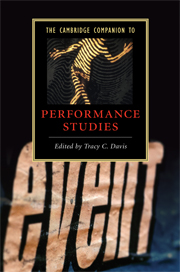Book contents
- Frontmatter
- Introduction: the pirouette, detour, revolution, deflection, deviation, tack, and yaw of the performative turn
- Part I Social polities: history in individuals
- 1 Performance and democracy
- 2 Performance as research: live events and documents
- 3 Movement’s contagion: the kinesthetic impact of performance
- 4 Culture, killings, and criticism in the years of living dangerously: Bali and Baliology
- 5 Universal experience: the city as tourist stage
- 6 Performance and intangible cultural heritage
- Part II Body politics: the individual in history
- Further reading
- Index
1 - Performance and democracy
from Part I - Social polities: history in individuals
Published online by Cambridge University Press: 28 January 2009
- Frontmatter
- Introduction: the pirouette, detour, revolution, deflection, deviation, tack, and yaw of the performative turn
- Part I Social polities: history in individuals
- 1 Performance and democracy
- 2 Performance as research: live events and documents
- 3 Movement’s contagion: the kinesthetic impact of performance
- 4 Culture, killings, and criticism in the years of living dangerously: Bali and Baliology
- 5 Universal experience: the city as tourist stage
- 6 Performance and intangible cultural heritage
- Part II Body politics: the individual in history
- Further reading
- Index
Summary
It is no doubt a coincidence that the internet user eager to know what democracy might be who types the question “What is democracy?” into Google should be directed first to a page on the website of the US Department of State. That the second-ranked hit leads to a lecture given by Larry Diamond at Hilla University in Iraq in January 2004 is similarly fortuitous, since Diamond, an academic expert in democracy who served as an advisor to the Coalition Provisional Authority in Iraq in 2004, went on to write a widely praised book that offered a sharply critical account of American efforts to promote democracy in the wake of the invasion of 2003. Despite Diamond's later criticism of the implementation of democracy in Iraq, he is broadly in agreement with the State Department in his answer to the initial question. The State Department's website offers this: “Freedom and democracy are often used interchangeably, but the two are not synonymous. Democracy is indeed a set of ideas and principles about freedom, but it also consists of a set of practices and procedures that have been molded through a long, often tortuous history. In short, democracy is the institutionalization of freedom. For this reason, it is possible to identify the time-tested fundamentals of constitutional government, human rights, and equality before the law that any society must possess to be properly called democratic.”
- Type
- Chapter
- Information
- The Cambridge Companion to Performance Studies , pp. 11 - 22Publisher: Cambridge University PressPrint publication year: 2008
- 7
- Cited by

